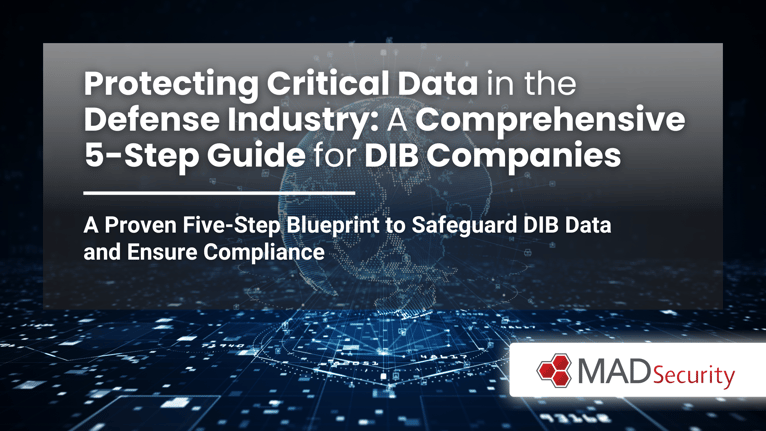
5 Steps for Defense Industry Base Companies to Effectively Protect Their Critical Data
As a Defense Industry Base (DIB) Managed Security Service Provider (MSSP) with subject matter expertise in solving cybersecurity issues, MAD Security understands the importance of effectively securing critical data. This blog post will discuss five essential steps DIB companies can take to protect their data and maintain compliance with NIST, DFARS, and CMMC 2 requirements.
Step 1: Identify Your Critical Data

The first step in protecting your critical data is to identify it. “Identify Your Critical Data” simply means understanding what types of data your organization holds, the value of the data, and the potential risks associated with losing or compromising that data.
As a DIB company, you likely have sensitive information related to defense contracts, intellectual property, and other proprietary information. Identifying this critical data is essential for ensuring that you can properly protect it from threats and comply with relevant regulations such as NIST SP 800-171, DFARS 252.204-7012, and the Cybersecurity Maturity Model Certification (CMMC) 2.0 framework.
By conducting a thorough data inventory and mapping exercise, you will gain a clear understanding of where your critical data is stored, who has access to it, and how it is transmitted within and outside your organization.
Step 2: Discover and Classify Your Data
Once you have identified your critical data, the next step is to discover and classify it. This involves using data discovery tools and software to scan your file stores, databases, and other data repositories to find assets that you can then classify according to their sensitivity or value.
By classifying your data, you can ensure that appropriate controls are implemented and consistently enforced. This is crucial for compliance with regulations such as NIST SP 800-171, which requires organizations to establish a system for managing Controlled Unclassified Information (CUI).
Consider using a user-driven data classification approach that combines human input with software toolsets for more accurate results when classifying your data. This will help your organization maintain better control over its critical data and make it easier to comply with CMMC 2.0 requirements for data protection.
Step 3: Implement Robust Data Security Measures

With your critical data identified and classified, the next step is to implement robust data security measures that will safeguard it from unauthorized access or use. This includes implementing data loss prevention (DLP) solutions, email gateways, and access control tools that work in conjunction with your data classification system to enforce your data security policies.
For example, DLP solutions will help prevent accidental or intentional data loss by blocking unauthorized uploads of sensitive files or preventing the transmission of critical data to external parties. This is particularly important for maintaining compliance with DFARS 252.204-7012, which requires contractors to provide “adequate security” for covered defense information.
Step 4: Monitor and Audit Data Security Compliance
Ongoing monitoring and auditing of your data security compliance are essential for ensuring that your organization’s critical data remains protected and that you continue to meet the requirements of NIST, DFARS, and CMMC 2.
Implement a security incident and event monitoring (SIEM) tool to detect potentially risky user behavior before a breach occurs. Additionally, use data governance tools for auditing access to sensitive information and maintaining a detailed audit trail of any risky activities. This will help you demonstrate compliance with regulatory requirements and quickly respond to any potential security incidents.
Step 5: Continuously Improve and Evolve Your Data Security Strategy

Finally, it’s crucial to continuously improve and evolve your data security strategy in response to changing threats, business requirements, and regulatory landscapes. This means regularly reviewing and updating your data security policies, technologies, and practices to ensure they remain effective and compliant with the latest NIST, DFARS, and CMMC 2 requirements.
Leverage monitoring and reporting tools to track data access, usage, and classification within your organization. This will help you identify areas for improvement and provide visibility into your overall data security posture. Use this information to make informed decisions about policy adjustments, employee training, or technology investments.
By integrating data classification, security technologies, and continuous monitoring, you can create a comprehensive and adaptive data security strategy that meets the evolving needs of your DIB company. This will help you protect your critical data, demonstrate the value of your security investments, and ensure ongoing compliance with industry regulations.
Conclusion
In conclusion, effectively protecting critical data for DIB companies requires a thorough and proactive approach that encompasses identifying, discovering, classifying, securing, monitoring, and continuously improving data security measures. By following these five steps and adhering to NIST, DFARS, and CMMC 2 requirements, your organization can safeguard its valuable information assets and maintain a strong cybersecurity posture in the face of ever-evolving threats. As an MSSP with expertise in the defense industry, we are here to help you navigate the complex cybersecurity landscape and implement best practices to protect your critical data.
About MAD Security
MAD Security is a veteran-owned cybersecurity managed security services provider (MSSP) specializing in providing security operation center (SOC) services to the defense industrial base and public sector government contractor companies. Our services include GRC Gap Assessments, GRC Policy Packages, Virtual Compliance Management (VCM), SOC as a Service (SOCaaS), User Awareness Training, Managed Endpoint Detection & Response (MSEDR), Managed Network Detection & Response (MSNDR), and Managed Email Security (MSES).
MAD Security is the premier Managed Security Services Provider that combines technology, services, support, and training to simplify the cybersecurity challenge. We regularly provide our services and expertise to defense industry-based contractors, aviation and aerospace companies, government contractors, financial institutions, technology services companies, higher education institutes, and manufacturing entities to manage risk, meet compliance requirements, and reduce costs. We stand ready to take on your day-to-day cybersecurity challenges and ensure your business is secure 24/7/365.
Original Published Date: May 9, 2023
By: MAD Security

